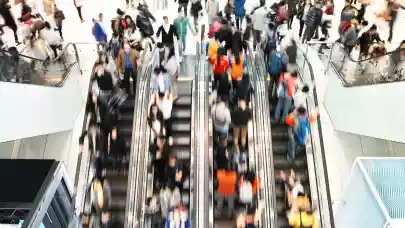
There is room for online and conventional channel retail to continue co-existing side by side in the short to medium term in the CEE-6 markets, according to Colliers International. The solid further €71.5 billion expansion of retail sales out to 2022, 4.9% growth per annum overall, creates enough evolutionary room for multiple concepts to continue thriving. Conservative growth scenario sees e-commerce in CEE-6 expanding 8.8% per annum from a baseline of €13.1 billion to €20 billion.
Mark Robinson, CEE Research Specialist explains: “We acknowledge that bullish estimates may put the size of the online market closer to that mark even today. But even in a more “bullish” scenario of e-commerce capturing 10% of all retail sales by 2022, expanding to €34 billion, we foresee a decent majority of incremental sales still occurring through the traditional, established channels”.
Is there space to expand?
The baseline expansion of demand via online channels and products delivered will generate, according to our calculations, a requirement for 198,000 sqm of dedicated logistics/warehouse distribution space per annum in CEE in 2018-22, if the assumption is made that present capacity is fully-utilised. This compares to the supply chain for conventional retail in the period requiring 865,000 sqm of logistics/distribution space per annum to service increased sales.
Adaptation rather than extinction
For the retail sector, the recent „showrooming“ concept should help the survival strategy. While we might not see any rent rises in CEE-6 due to the online threat and some hard negotiations ahead, the markets do not appear very „overbuilt“ at present. The sheer rate of increase of overall retail sales means that it is very difficult to portray that omnichannel/traditional retail growth will taper towards nothing, even taking into account inflation. Significant wage increases, strong GDP growth and the increasing availability of credit should keep retail afloat.
At what stage of evolution is e-commerce?
E-commerce is playing a full part in the fast growth of the service sector in the CEE-6 countries. But the amorphous nature of the rapid growth of online sales makes precise estimation tricky. To obtain consistency, we have adopted the Statista estimates for market size in 2017 and their projections forward to 2022 that were published in their 2018 study. The Statista study was based on a model cast (in US dollar terms) using extensive surveying of 13 European countries (including Poland) and others around the world. The 2017 market size in CEE-6 using Statista’s assumptions is €13.1 billion.
Other sources see the market size in the CEE region much higher but taking the highest estimates in each market would sum the CEE-6’s market size in 2017 to €20.1 billion.
We set the Statista data against retail sales in the CEE-6 and across Europe as a test of these estimates and to attempt to assess the opportunity for future growth prospects. The Statista 2017 market sizes plot below a linear line of best fit in Romania, Czechia and especially Poland.
How fast will e-commerce grow?
Using projections from Statista, we believe that total e-commerce revenues in the CEE-6 as a baseline conservative scenario will grow 9% per annum by 2022. We expect the region’s 3.1%-5.6% 2017 Statista data range of ratios to total retail sales should expand to at least 3.7%-6.9% by 2022, totalling a minimum of €20 billion in revenues and increasing by more than €6.9 billion.
Growth for CEE logistics real estate
The combined 1.063 million sqm of space required in our conservative baseline 9% expansion of e-commerce within 4.9% overall retail sales growth equates to 3.3% of present modelled logistics/ distribution stock in the CEE-6. But more interestingly equates to 62% of Q2 2018’s active construction figures and 87% of modelled take-up for the last 4 calendar quarters.
It is in the scenarios of higher proportions of retail sales being online that additional logistics/distribution capacity will be required. For e-commerce, we model a sales per sqm ratio about half that of conventional/omnichannel retailers. This difference generates an absolute terms requirement for space of an average of an extra 107,000 sqm per annum in our “bullish” scenario in 2022, where the share of e-commerce is just over 10%. In our ambitious “high” scenario, where e-commerce rises to 13.2% of retail sales on average across the CEE-6, the extra space required would be 263,000 sqm.
Impact on CEE retail demand
Our “conservative” scenario’s €6.9 billion online retailing increment takes a 10% chunk out of the overall projected growth in retail sales of €71.5 billion in 2018-22E. The extreme scenario of e-commerce absorbing all retail sales growth from now to 2022E looks out of scope. It would imply online sales rising to 19%-29% of retail sales across CEE-6. The UK’s level is 15.2% now. Our “bullish” scenario implies €34 billion of online sales, absorbing 20% of all retail sales growth by then. Important is that 80% of incremental sales would be omnichannel/traditional. So even taking inflation into account, there is demand coming via these channels.
So, should any closures of retail units occur? Probably not, overall. We have detected none yet. Assessing the CEE-6 capital cities’ Q2 2018 TSC retail space per capita against their 2015 GDP per capita suggests slightly overbuilt situations or room to absorb higher sales.
How will retail rents develop?
We do not see retail rents firming in the face of our modelled e-commerce expansion. Negotiations and agreements on turnover rents and recognition of online sales are going to be required. But neither do we see large rent reductions, as the CEE-6 omnichannel/ traditional increment is still worth at least €27 billion between 2018E-22 in our “high” scenario.
A potential survival aid, the “showrooming” phenomenon, is spreading in CEE-6 (excepting Bulgaria), now accompanying and flagging the growth of e-commerce. Some of the largest e-electronics and e-fashion & cosmetics players have already established pick-up point presence in well-located offices and at transport nodes in the larger cities (see below for details).



